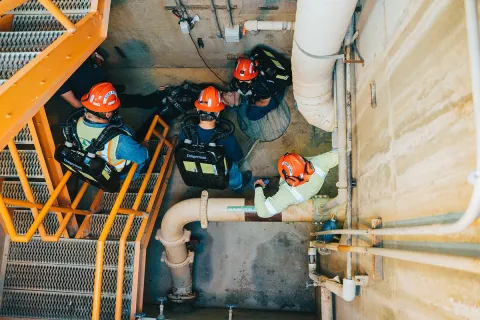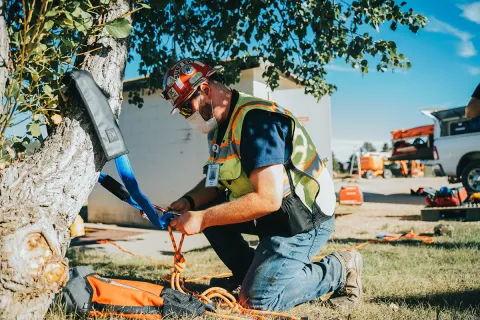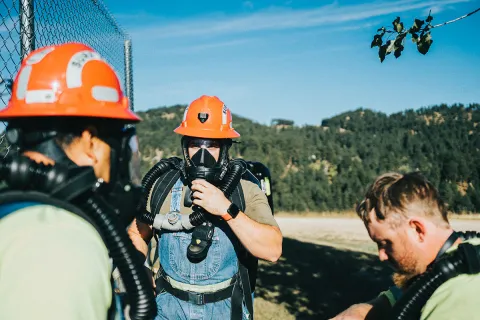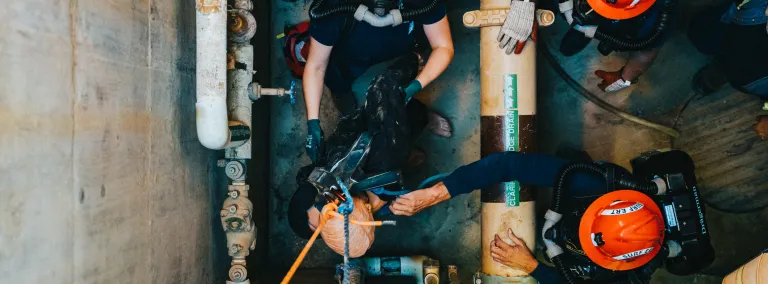Ready for rescue
SURF’s Emergency Response Team is poised to respond to facility and community emergencies
On a bright fall morning, Paul “Woody” Hover watched a rescue unfold. Neon reflective gear glinted in the sunlight as more than a dozen Emergency Response Team (ERT) members worked near a small, unused outbuilding at the Sanford Underground Research Facility (SURF).
No one was in danger—it was a drill, just part of the job for SURF ERT members, said Hover, who is the team lead for the ERT. “We train and train and train, all the while hoping we never have to do this here.”
As part of the drill, four team members secured full-face breathing apparatus and entered the outbuilding. Inside, they descended a steep stairwell and found their “patient”—a training mannequin—at the base of the stairs. After discussing proper medical responses to this scenario, the team began securing the “patient” for a rope rescue.

SURF ERT members assess the training mannequin and discuss proper medical responses to this training scenario. Photo by Adam Gomez
Outside, other team members worked quickly, creating a rope retrieval system near a utility hole that opened into the underground space. Communicating with the team below, they began lifting their “patient” the 30 feet to the surface.

James Dietz, member of SURF ERT, prepares for the rope rescue training scenario. Photo by Adam Gomez
The multi-faceted training scenario covered confined space entry, working in full-face breathing apparatus, evaluating a patient and performing a rope rescue.
Emergency response at SURF
At SURF, the Environment, Safety and Health (ESH) Department works to eliminate and address hazards through a comprehensive safety program. And, having an on-call team of highly skilled emergency responders who are familiar with the facility’s design and site-specific hazards is a major key to success.
“I want people at SURF to know that a team of highly-trained individuals are here, training and thinking ahead,” said Julie Ewing, director of ESH. “And that makes me feel better, confident and secure working here.”
With 12 full-time team members and 21 part-time (or volunteer) members, SURF’s ERT is prepared to respond to an emergency at any time.
All full-time members are certified with the National Registry of Emergency Medical Technicians. And with a variety of professional backgrounds, including emergency room nurse, flight paramedic, firefighters and mine rescue professionals, the team has diverse expertise.
The team constantly puts these skills into practice through their robust training program, including daily training for full-time members, monthly exercises for all members, and quarterly site-wide evacuation drills.
“We try to be as practical as possible and train for what we might encounter at this facility,” Hover said. “We use traditional mine rescue standards as the basis for our training, and then build on that according to that science-specific hazards at the facility.”

Members of SURF ERT don full-face breathing apparatus during training scenario. Photo by Adam Gomez
But this team isn’t just for SURF—they are ready to respond to any emergencies that may arise in the community.
“We also view this team as an opportunity for outreach. If there’s a local emergency—if someone gets lost or hurt—we are prepared to help, because we have the tools and the people to do just that,” Ewing said.
To prepare for a potential community response, ERT cross trains with local fire departments and Search and Rescue teams; Civil Support Teams in South Dakota, Wyoming and Montana; and the Department of Homeland Security.
SURF’s ERT has openings for part-time team members. If you’re interested in applying for a part-time position, contact Paul “Woody” Hover at phover@sanfordlab.org or (605) 722-6004.
